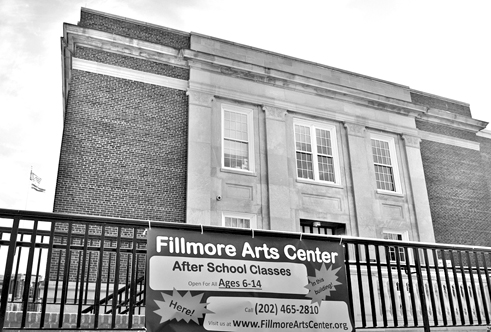Chancellor Rebuffs Plea to Reverse Fillmore Cuts

By Deirdre Bannon
Current Staff Writer
Despite urgent calls from parents at several District schools to reverse funding cuts for the Fillmore Arts Center, the D.C. Public Schools system is arguing that the arts education program doesn’t serve enough schools to justify a higher allocation.
According to Friends of Fillmore, a volunteer group that supports the arts center, Fillmore is projected to serve about 3,000 students next year, about the same number that attended during the 2011-2012 school year — yet Fillmore’s budget is down by at least $250,000.
D.C. Public Schools says that budget cut is due to the drop in the number of participating schools, from 11 to eight, but Fillmore supporters argue that the budget should be based on the number of students.
Fillmore offers a music, visual arts, drama and dance curriculum to pre-kindergarten to eighth-grade students from eight schools, including five in Northwest, at its two co-locations — Hardy Middle School in Georgetown and Raymond Education Campus in Petworth. The program was founded under the principle that arts education in a central location could provide a stronger curriculum and more resources than neighborhood schools could offer on their own.
The program has had its budget reduced by more than 40 percent over the past four years, to just over $1 million as proposed for the 2014 fiscal year, according the Friends of Fillmore and other stakeholders. Fillmore supporters fear the current per-pupil funding cuts are so significant that the nearly 40-year-old program may no longer be viable.
PTA presidents from Key, Hyde-Addison, Marie Reed, Ross and Stoddert elementary schools — the five Northwest schools served by Fillmore — sent a letter last month to D.C. Public Schools Chancellor Kaya Henderson urging her to restore the art center’s budget. There’s also an online petition asking the same, which now has more than 1,000 signatures.
On Friday, Henderson responded that budget cuts are a result of fewer schools and students participating in Fillmore’s program next year — and she noted that Fillmore principal Katherine Latterner has had the chance to recruit new schools.But stakeholders like Key Elementary School PTA president Sunny Kaplan say the chancellor “is off the mark.”
“The cuts we are protesting are not related to the fact that four schools are not continuing with Fillmore. … We are talking about per-pupil funding, which is down 40 percent over four years,” Kaplan wrote to Henderson on Tuesday.
Further, Kaplan argues that there was no opportunity for Fillmore principal Latterner to recruit additional schools because “DCPS put specific instructions in the budget book that forbade new schools from signing up for Fillmore. Only later, after the budget process was finished and all the schools had finalized their staffing and plans, did DCPS allow more schools to sign up for Fillmore. These schools had already hired teachers, gotten their budgets approved by their [local school advisory teams],” she wrote to Henderson.
“DCPS appears to be building a case that schools are fleeing Fillmore, and we’re unable to recruit new ones. This, again, is a fiction perpetuated by DCPS,” said Kelly Richmond, Friends of Fillmore board president.
D.C. Public Schools spokesperson Melissa Salmanowitz said yesterday she wasn’t immediately familiar with Kaplan’s letter and couldn’t respond to questions before The Current’s deadline.
In Henderson’s testimony before the D.C. Council Committee on Education’s budget oversight hearing Thursday, the chancellor said repeatedly that public school budgets are based on enrollment figures and that “the money follows the children.”
But Fillmore stakeholders say the school system isn’t actually applying that standard to the arts program, which is instead allotted funding based on the number of participating schools, rather than the enrollment figures. Stakeholders say that’s at the crux of the problem and that Henderson and D.C. Public schools officials won’t address it.
“DCPS has never substantively engaged with what Friends of Fillmore or the Fillmore Arts Center’s constituency has to say about the budget,” said Tilman Wuerschmidt, the Key Elementary PTA representative to Friends of Fillmore. “They will only say that the number of participating schools is why they reduced funding, and any other rationale, like looking at per-pupil funding, is completely irrelevant to them. It’s incredibly frustrating.”
Fillmore historically relied on per-pupil funding, but in recent years participating schools instead have been asked to contribute the amount they’re allocated for arts and music teachers — anywhere from the value of one to three faculty member salaries, depending on the size of the school. The school system recently reduced that allocation by half a salaried position per school to fund a world languages program.
Mary Levy, a longtime expert on D.C. Public Schools budgeting, conducted an independent analysis of the projected cuts to Fillmore. She found that D.C. Public Schools has reduced the number of arts and music positions at five of the eight schools slated to attend classes at Fillmore next year — and because those schools turn over that funding to pay for Fillmore, the art center’s budget is down about $250,000.
At-large Council member David Catania, who chairs the Education Committee, was critical at Thursday’s hearing of the cuts several schools were slated to absorb in the school system’s budget proposal — which ranged from 5 to 17 percent. He proposed capping any one school’s budget cuts at 5 percent, so there would be a “softening of that consequence when we have dramatic reductions,” and so cuts aren’t “so dramatic that it has the effect of destabilizing the school and disrupting the program for those children who remain.”
Catania said he would look to establish a stabilization fund for schools so impacted, but it’s unclear whether Fillmore would be included in that plan.
This article appears in the May 8 issue of The Georgetown Current newspaper.
